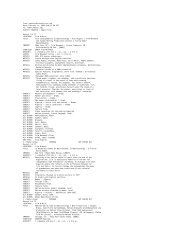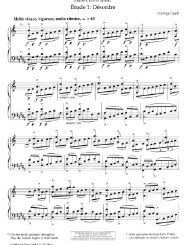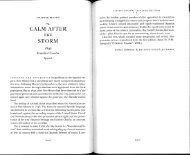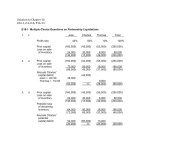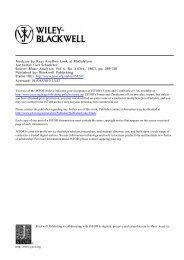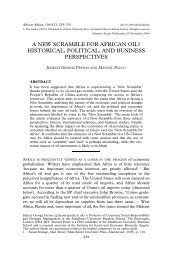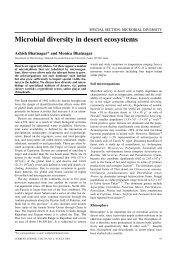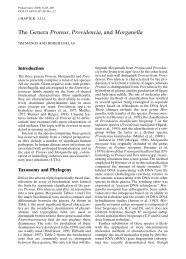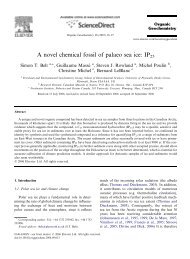The Genus Serratia
The Genus Serratia
The Genus Serratia
You also want an ePaper? Increase the reach of your titles
YUMPU automatically turns print PDFs into web optimized ePapers that Google loves.
230 F. Grimont and P.A.D. Grimont CHAPTER 3.3.11<br />
<strong>The</strong> pH is adjusted to 7.2. Autoclave at the same time as<br />
solution A. After autoclaving, solutions A and B are<br />
mixed aseptically, and the resulting medium is poured in<br />
thick layers into sterile, plastic petri dishes (25–30 ml for<br />
petri dishes 9–10 cm in diameter). <strong>The</strong> medium is no<br />
longer effective if it is remelted, but plates of CT agar<br />
keep well for several weeks at 4°C if contamination and<br />
desiccation are prevented.<br />
CT agar is very useful for the isolation of <strong>Serratia</strong><br />
spp. (except S. fonticola) from feces, sputum,<br />
and any other polymicrobial clinical sample.<br />
<strong>Serratia</strong> colonies are apparent within 3 days, and<br />
further incubation allows colonies grow (2–5<br />
mm). Occasionally, Providencia spp., Acinetobacter<br />
spp., or Pseudomonas spp. may develop<br />
colonies on this medium. Other bacteria give<br />
only pinpoint colonies. When samples are from<br />
the natural environment or food, the results are<br />
less clear, especially if the sample contains nutrients.<br />
Several colonies must then be checked for<br />
DNase. Preenrichment in nutrient broth with<br />
4% NaCl, incubated overnight at 20°C, can be<br />
used; about 0.1 ml of the enrichment culture is<br />
streaked onto CT agar. Broth that has supported<br />
overnight bacterial growth usually does not<br />
contain enough nutrients to adversely affect<br />
the selective isolation of <strong>Serratia</strong> spp. (P. A. D.<br />
Grimont, unpublished observations).<br />
Identification<br />
<strong>The</strong> usual methods for the identification of<br />
serratiae and other Enterobacteriaceae can be<br />
found in Ewing (1986). However, following the<br />
pioneering example of Stanier et al. (1966) with<br />
the pseudomonads, developments in enterobacterial<br />
taxonomy (Bouvet et al., 1985; Grimont<br />
and Ageron, 1989; Grimont et al., 1977b; Grimont<br />
et al., 1988) have demonstrated the usefulness<br />
of carbon source utilization tests. Also, it<br />
should be noted that utilization tests are preferable<br />
to fermentation tests since strains able to<br />
utilize a polyalcohol sometimes fail to produce<br />
enough acid products to give a positive reaction<br />
in fermentation tests. Although all species can be<br />
identified with carbon source utilization tests,<br />
some conventional tests can also be used:<br />
tetrathionate-reduction and β-xylosidase tests<br />
are useful in clinical identification (Le Minor et<br />
al., 1970; Brisou et al., 1972). <strong>The</strong> methodology<br />
of carbon source utilization tests and other procedures<br />
that are not in general use, but are essential<br />
to <strong>Serratia</strong> identification, are detailed herein.<br />
Conditions of Incubation<br />
Best results are obtained when <strong>Serratia</strong> cultures<br />
are incubated at 30°C. At 37°C, pigmentation<br />
often fails to appear, and the Voges-Proskauer<br />
test is often negative. S. plymuthica may even fail<br />
to grow at 37°C. Otherwise, there is little difference<br />
between the results of tests held at 30°C<br />
and those held at 37°C as far as S. marcescens is<br />
concerned.<br />
Carbon Source Utilization Tests<br />
Two methods can be used for carbon utilization<br />
tests: a minimal agar medium or API strips (API<br />
System, La Balme-les-Grottes, France).<br />
<strong>The</strong> minimal agar medium employs the same<br />
M70 medium (Véron, 1975) used in the caprylate-thallous<br />
selective agar (see the recipe), but<br />
omits the yeast extract, thallous sulfate, and<br />
caprylate from solution A. Neutralized carbon<br />
sources (the purest brand available) are added<br />
to solution A to give a 0.1% final concentration<br />
(weight of the anion/vol) in the complete<br />
medium (0.2% in the case of carbohydrates).<br />
Sterilization of the carbon source in aqueous<br />
solution is achieved by filtration throught membrane<br />
filters or by heating at 80°C for 20 min.<br />
Plates are examined for growth after 4 days<br />
(early reading) and 14 days (late reading).<br />
<strong>The</strong> API strip method uses API 50 CH (containing<br />
49 carbohydrates), API 50 AO (49<br />
organic acids), and API 50 AA (49 aminoacids)<br />
galleries and a minimal medium containing<br />
growth factors provided by the manufacturer.<br />
<strong>The</strong>se were described by Gavini et al. (1980).<br />
Since about one-third of the carbon sources are<br />
useless in the study of the Enterobacteriaceae,<br />
we use special galleries containing 99 selected<br />
carbon sources (including new compounds not<br />
included in the above-mentioned galleries). <strong>The</strong><br />
inoculated galleries are examined for growth<br />
after 2 days (early reading) and 4 days (late reading).<br />
<strong>The</strong>se galleries have been used for the<br />
description of several bacterial groups (Bouvet<br />
et al., 1985; Grimont et al., 1988; Grimont and<br />
Ageron, 1989).<br />
In our experience, carbon source utilization<br />
tests (CSUT) gave reproducible and clear-cut<br />
results. Utilization of carbohydrates and polyalcohols<br />
often give more useful results than fermentation<br />
tests (FT). More than 95% of CSUT<br />
and FT using D-xylose, L-arabinose, trehalose,<br />
sorbitol, sucrose, and rhamnose gave the same<br />
results (P. A. D. Grimont, 1977). However,<br />
results with CSUT and FT are not parallel when<br />
adonitol, inositol, cellobiose, and lactose are<br />
studied. Whereas almost all <strong>Serratia</strong> strains can<br />
grow on inositol, acid from inositol was produced<br />
by only 76% of S. marcescens, 36% of S.<br />
rubidaea, 92% of S. liquefaciens-S. proteamaculans<br />
and 35% of S. plymuthica strains within 2<br />
days. CSUT with adonitol is a very good test for<br />
separating S. marcescens from S. liquefaciens<br />
(99% vs. 0% positive strains, respectively), but



